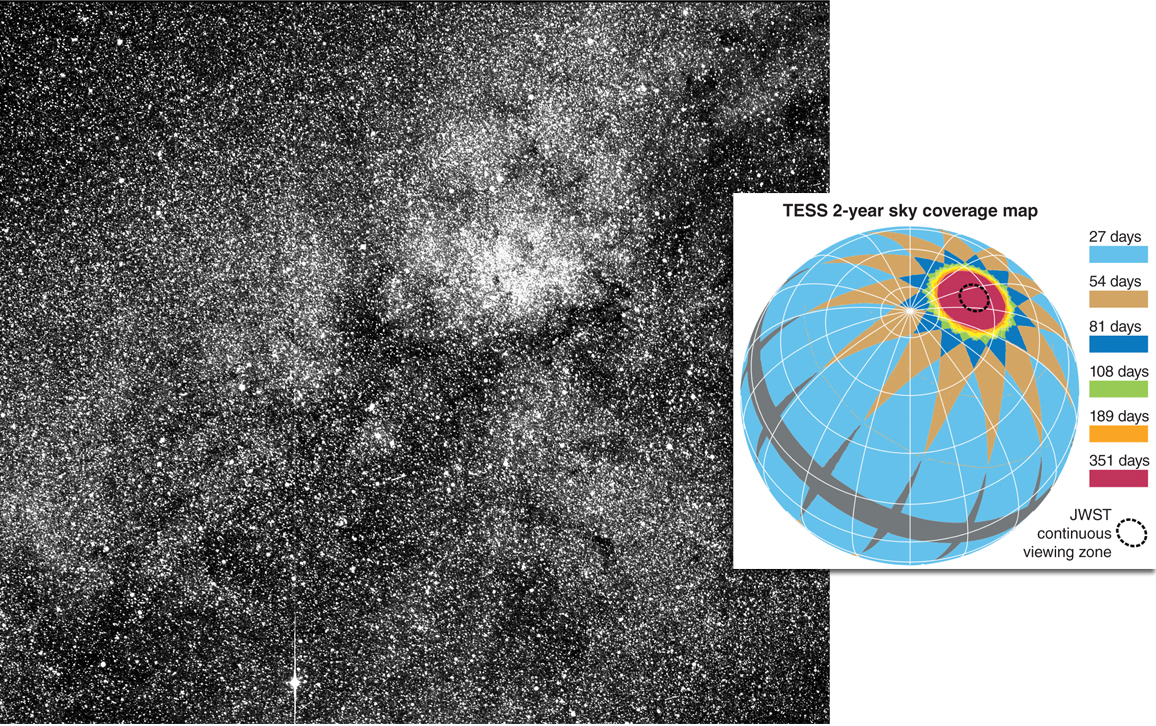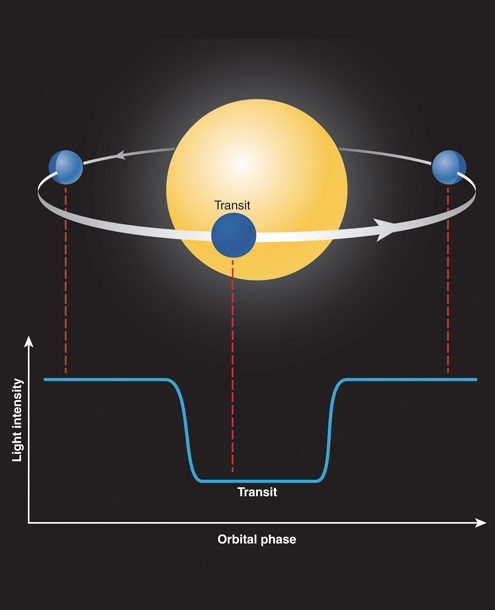What's Next for Finding Other Earth-like Worlds?
By Sara Seager
The Transiting Exoplanet Survey Satellite is just getting started.
The Transiting Exoplanet Survey Satellite is just getting started.

On April 18, 2018, a cloudless blue-sky day, my heart pounded with anticipation during the last few seconds of the countdown for a Space-X Falcon 9 rocket, which was ready to fire and lift off from a launchpad at Cape Canaveral. Sitting inside the rocket’s nose cone was a small payload known as TESS—the Transiting Exoplanet Survey Satellite, a NASA mission led by scientists and engineers at the Massachusetts Institute of Technology (MIT). More than a decade of work had gone into the satellite, and now it was time to send it to space. The launch was spectacular. Even at our viewing site six miles away, the rocket’s plume was so bright and the blue sky so sunny that we had to squint to see the spacecraft make its way toward the stars.

MIT TESS Science Office
TESS is a planet-hunting telescope. It will survey large swaths of sky looking for worlds orbiting bright stars not too far from Earth. The satellite is the brainchild of principal investigator George Ricker and his colleagues—who, more than a decade ago, tried to use guide cameras from the High- Energy Transit Explorer (HETE-2), their then-retiring space mission, to detect slight dips in brightness that occur when a planet moves in front of the face of its star and briefly blocks some of the star’s light. The mini-eclipse that results is what we call a planetary transit, and of the 3,700 confirmed exoplanets detected to date, many have been discovered using this technique of looking for dips.
Whether such worlds even exist is a question people have wondered about for ages, but only for the past few decades have we had the tools to search for planets beyond our Solar System. The first discoveries came from ground-based telescopes, and then space-based satellites. But it was the Kepler Space Telescope—the first true planet hunter—that solidified the existence of worlds well beyond the Solar System. Prior to its 2009 launch, we knew of only a few hundred exoplanets. After Kepler, we knew of thousands. TESS will follow in Kepler’s footsteps, scrutinizing upwards of 200,000 nearby stars for signs of planets—another step in the search for a habitable world beyond Earth.
Detecting transiting planets is challenging. The drop in brightness of a star during a transit is tiny, ranging from a 1-percent drop down to a 1/100th of a percent drop, depending on the size of the planet and star. Transits also require a fortuitous alignment, as the planet’s orbit has to be dead-on with our line of sight with the star. The more stars we look at the better, because the probability for the right alignment to produce a transit is low—somewhere between 1 in 10 to 1 in 200, depending on the star size and on how far the planet is from the star.
To study the stars in search of transits, TESS has four identical, specialized cameras, all anchored to the same platform. The cameras are about 10 centimeters in diameter, with seven lens elements leading to a 16-megapixel detector. Each camera has a giant baffle to block out stray light from the Earth and the Moon, and each camera has a wide field of view, covering 24x24 degrees of arc in the sky, an area that would contain about 2,500 full moons or the entire constellation of Orion. Together, the cameras cover a strip, or sector, of the sky measuring an unsurpassed 90x24 degrees.
After observation of each sector is completed, TESS will downlink data on about 20,000 stars that have been recorded at two-minute intervals, and data on hundreds of thousands of stars recorded at 30-minute intervals. TESS will stare at each sector for about 28 days, tiling the sky’s southern hemisphere with 13 sectors in the first year of its operation and tiling the sky of the northern hemisphere with 13 sectors in its second year.
During its two-year mission, TESS will search 85 percent of the sky for planets orbiting stars. Kepler was more focused, covering only 0.25 percent of the sky, but peering deep into space, to a distance of some 3,000 light-years from Earth, and staring at stars for months at a time. TESS will study stars only a couple of hundred light-years from Earth for a little less than a month at a time, but still it will detect some 30 million celestial objects. The brighter stars targeted by TESS are also much better candidates for follow-up studies.
TESS, like the pioneering Kepler mission before it, conjures a new paradigm for astronomy: not the old astronomer on a lonely mountaintop, smoking a pipe while looking through the eyepiece of a large telescope, but a younger crowd of people dispersed all around the world, compiling blocks of custom-made or open-source computer programming code that will help to automatically search stars’ data for drops in brightness that could be due to transiting planets.
TESS’s mission is to zero in on nearby stars and identify those with planets that are Earth-size or slightly bigger.
Data processing for TESS begins aboard the spacecraft, where the wide-field images are compressed and sent down to Earth through NASA’s Deep Space Network. The images are “unpacked” at MIT: The data is calibrated and run through a “quick look” pipeline, which analyzes the images to ensure that the cameras are working properly and to take a preliminary survey for planetary transit signals. The data is simultaneously sent to NASA’s California-based Ames Research Center, where they are fully analyzed to find transitlike events significant enough to warrant further study.
Data reports are automatically generated for each object that the software flags as potentially significant. The information is then used by the MIT TESS Science Office, both by human and computer vetters, to determine whether the object is just an artifact, an eclipsing binary star, or a planet candidate worthy of additional observation.
Next, the list of planet candidates, along with the raw data and data products, are sent out to the astronomy community so that the TESS team and others around the world can do follow-up observations with telescopes on the ground and in space. About 100 people, from 30 different institutions in the United States and 15 other countries, have signed up for the TESS Follow-up Team, which will check to see whether the planet candidates are, in fact, genuine planets, and in some cases they will measure the planets’ masses.
TESS’s rasion d’être is to find 50 small planets with measured masses. We anticipate that a subset of these planets will be transiting in the habitable zone of small stars—planets that are not too hot and not too cold, but possibly just the right temperature to support life. Winnowing the spacecraft’s detections down to 50 small planets may seem inconsequential compared with the thousands of planets discovered by Kepler, but TESS has a different mission: to zero in on nearby stars and identify those with planets that are Earth-size or slightly bigger.
TESS will not find Earth-like planets orbiting Sun-like stars. Instead, the spacecraft has a sweet spot—searching for Earth-size planets transiting low-mass, red dwarf stars.
Red dwarf stars, which are smaller and cooler than the Sun, are very common and long-lived, making them interesting targets in the search for life. Because the stars themselves are small, the dips in brightness caused by a transiting planet is easier to spot. Also, the transits happen more often, because of Kepler’s Third Law: A planet located close to a red dwarf star in its habitable zone orbits its star more frequently—every few days or every few weeks, typically—than does a planet in the habitable zone of a Sun-size star. More stars are better and so are more transits, especially when it comes to searching for signs of life.
A transit is important for identifying a planet, and it can also give clues to the gases that comprise a planet’s atmosphere. As the planet passes in front of the star, some of the star’s light shines through the planet’s atmosphere, and the composition of that atmosphere is imprinted on the starlight—that is to say, the planet’s atmospheric gases block some starlight from shining through. TESS’s discoveries set the stage for studying planets’ atmospheres with future spacecraft, including the James Webb Space Telescope (JWST), set to launch in 2021.

Jason McAlexander
With JWST and other space telescopes to come, we will be searching especially for water vapor, which is indicative of liquid water oceans on small planets and which is needed for all life as we know it. We will also be looking for gases—such as oxygen, methane, and nitrous oxide—that are present in huge quantities and do not belong in the context of other gases. Our hope is to deduce whether some of them are biosignature gases—those that can be attributed to life.
A burning question in this field is, When will we find signs of life on another planet? My answer is that once we combine the information about the small planets transiting small stars discovered by TESS and other searches with detailed observations by the JWST, we will have the capabilities to find signs of life on another planet within the next few years. But, for that to happen, nature must provide planets with forms of life that generate obvious atmospheric signatures. Finding those planets may take some detective work.
The difficulty of the task should not deter us but instead make us all eager to delve into the data. The TESS mission truly is for everyone. The data has no proprietary time, so all astronomers have a chance to make discoveries and to implement their new ideas in data processing and discovery science. And the mission is not just about planets: Astronomers may propose to get data from TESS for either exoplanet or non-exoplanet science through NASA’s Guest Investigator Program to study everything from stellar evolution and stellar asteroseismology (star oscillations) to extremely energetic black holes in distant galaxies. Researchers could even use TESS data to search for very young planets around newborn stars. The public will not be left out, either. We anticipate that TESS data will be put onto crowdsourcing sites, such as planethunters.org, where space enthusiasts can try their hand at identifying worlds far beyond the Solar System.
After TESS will come missions of a new type, such as Starshade Rendezvous Mission, the Habitable Exoplanet Observatory, and the Large Ultraviolet/Optical/Infrared Surveyor, which will take direct images of exoplanets. As with all new space-telescope “eyes on the sky,” the best discoveries will probably be the ones we haven’t thought of yet. For planetary explorers, there are bound to be exciting times ahead.
An audio interview with the author:
Click "American Scientist" to access home page
American Scientist Comments and Discussion
To discuss our articles or comment on them, please share them and tag American Scientist on social media platforms. Here are links to our profiles on Twitter, Facebook, and LinkedIn.
If we re-share your post, we will moderate comments/discussion following our comments policy.